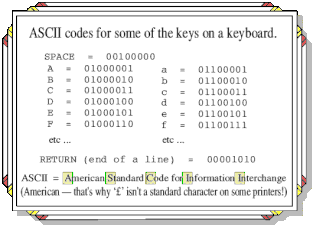Data Representation
Data Representation refers to the methods used to represent information stored in a computer. Computers store lots of different types of information: discrete information like numbers and letters, or continuous information like sounds and images. They use numeric codes to represent that data. The information is stored in a series of zeroes and ones known as binary code. Data is transmitted within a computer by electrical signals that are either on or off. On = 1, off =0.
|
Resources:
BBC Bitesize - Data Representation BBC Bitesize - Binary Data Representation - Unplugged - teaching data representation without computers CS Field Guide - Data representation Binary numbers videos Flowcharts |

ASCII and Unicode Code
Computers can't understand letters (or base 10 numbers) so any letters typed into a computer need to be converted into binary code. This is usually done using the ASCII (pronounced ask-ee) format which stands for American Standard Code for Information Interchange. Each letter is assigned a number which is then converted to binary. A for example is 65 or 01000001. Lowercase a is 97 or 011000001. ASCII code however, can only store 128 characters, which is enough for most words in English but not enough for other languages such as Cyrillic or Mandarin where more characters are needed. For these you would need to use another code known as Unicode. |
2017

